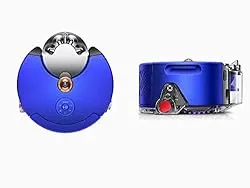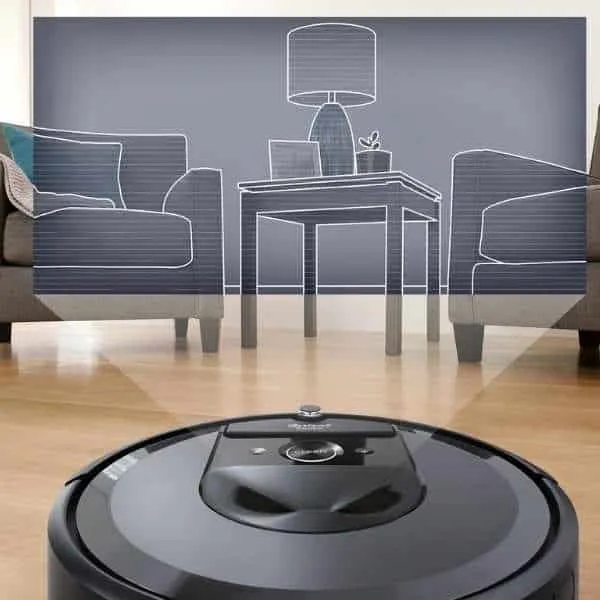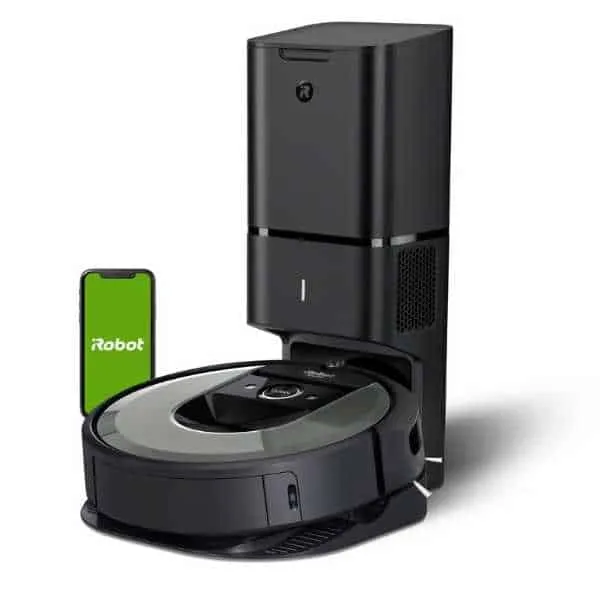Dyson 360 Heurist vs Roomba i7+ [Side-by-Side Comparison]
Dyson are a top player in the world of vacuum cleaners, but when it comes to robot vacuums, this is iRobot’s playing field. In this review, we’ll compare two of the most popular robot vacuums from these two giants. But which is better, the Dyson 360 Heurist or the iRobot Roomba i7+?
Well, the Roomba i7+ is our favoured robot vacuum over the 360 Heurist. Both provide an excellent clean, but the Roomba is far more advanced with features such as auto head adjustment to account for different carpets and a base that empties itself.
In the rest of this article, we’ll go through all of the similarities and differences between the two robots with a detailed side-by-side comparison.
Note: Roomba i7 refers to the vacuum itself whereas i7+ includes both the vacuum and self-emptying base
Table Of Contents
- Overall Verdict
- Specs Comparison Table
- Dyson 360 Heurist: Pros and Cons
- Roomba i7+: Pros and Cons
- Full Comparison
- Closing Thoughts
| Image | Summary | |
|---|---|---|
| Top Pick: Roomba i7+ • Self-emptying base • Rubber rollers are great at picking up hair | View on Amazon | |
 | Best Value: Dyson 360 Heurist • Patented cyclone technology for suction power • Slim design allows it to fit between obstacles | View on Dyson |
Overall Verdict
These are both excellent robot vacuum cleaners with mapping, innovative features such as zoned cleaning and recharge-and-resume. Dyson have packed in a powerful suction ability, but this alone isn’t enough to compete with the Roomba which is very intelligent to detect different floor types and adjust the height of its cleaning head and suction power accordingly. For this reason, the Roomba gives a better overall clean and is far better at picking up hair thanks to the rubber rollers as opposed to Dyson’s traditional vacuum bristles.
Add to this some of the other features that Roomba has, including more voice commands, dirt detect and of course, the self-emptying base that requires less frequent intervention and is particularly appealing to larger homes.
The Roomba i7+ does come with a slightly higher price tag of these two products but offers more value. If you are concerned about price, the i7 without the clean base is still a great choice and we’d recommend this over the Dyson Heurist too.
Winner: iRobot Roomba i7+
Specs Comparison Table
[table id=10 /]
Dyson 360 Heurist: Pros and Cons
The 360 Heurist is Dyson’s second-generation robot vacuum. Much has remained the same including the way it looks, the use of Dyson’s cyclone vacuuming technology and the visual mapping that allows it to create floor plans. It has had some upgrades including a bigger memory that will seemingly help it’s AI and an LED light ring that helps it clean in the dark, something the previous version was missing.

Great suctioning power due to patented Cyclone technology
Small size allows it to clean around areas tough to reach e.g. around the legs of the couch
It does well with crevices too
LED lights feature to allow it to clean at night and in low light areas
Cheaper of the two products
Gets clogged easily while cleaning large particles and hair
Small dustbin capacity
Tall size means it can’t clean under low furniture
Roomba i7+: Pros and Cons
The Roomba i7 is one of Robot’s newer robot vacuum cleaners and whilst it’s not their very top tier device, it features a lot of their advanced intelligence and cleaning performance. The i7+ comes coupled with the clean base, a self-emptying base that sucks the dirt out of the onboard bin into a larger bin in the base. It also maps your home, has an auto head adjustment and can change suction power according to the floors needs.
i7+ includes the self-emptying base
Pet filter feature cleans up 99% of mould, pollen, dust mite, dog and cat allergens
Seamless transition between different floor types thanks to automatically adjusting head height
Can get under low furniture
Doesn’t clean hard floor as well as carpet
Gets scratched easily with white baseboards or other painted structures
Slightly more expensive
Full Comparison
Now, we’ll jump into the full comparison of the Roomba i7 vs the Dyson Heurist and see how they fare against each other in terms of design, mapping, battery life, cleaning performance, and other features.
Design
The Dyson 360 Heurist is an unusual shape for a robot vacuum, opting for a taller body with a narrower diameter. It’s thanks to this that the Dyson can find its way around hard to reach areas such as between chair legs and under tables. The wheels are more like tank tread which helps it navigate over thresholds and carpets.
Conversely, Roomba have taken a more traditional approach with the i7, opting for a wider, but shorter body that is better at getting under low furniture than the Dyson.
The Roomba i7+ comes in two main parts – the robot vacuum cleaner itself and its 48cm tall clean/recharging base. It automatically disposes the debris into the bag at the cleaning base.
Based on the design, both products have their differences, each comes with advantages that may suit your home better. Hence, we’ll call it a draw here.
Design Verdict – Draw
Mapping
Both the Dyson 360 Heurist and the Roomba i7 use vSLAM (Visual simultaneous localization and mapping) as their method of mapping. This relies on visual cameras to map out the room using key landmarks in the room to navigate. Both vacuums create floor plans that are stored in the map and can work on multiple floors in your home.
The robots will map your home, then you can create rooms in the app and set different cleaning schedules for each room. The Dyson allows you to set different cleaning modes for each room, whereas the Roomba automatically detects the floor type and adjusts the cleaning settings automatically.
The previous generation of Dyson struggled to navigate low-light areas effectively, however the Heurist fixes this thanks to a ring of LED lights on the top that illuminate the room so that the cameras can see.
Both products allow you to create virtual barriers to block off certain areas that you don’t want the robots to clean, this might be areas where they are prone to get stuck.
The mapping features of both robots compare well against one another and we’ll like to call it a draw in mapping too.
Mapping Verdict – Draw
-

Dyson maps and cleans room by room (credit: Dyson)
-

VSLAM Mapping on the Roomba i7 (credit: iRobot)
Battery Life
The Dyson has a run time of 75 minutes at the low power mode and 45 minutes at high power mode before it’ll need recharging. It also can resume from the spot it stopped cleaning before the recharging.
The Roomba i7+ runs on a 3,300mAh Li-Ion battery. The battery can run up to 90 minutes before it returns to the clean base for a recharge. The Roomba i7+ wins this round because it has a longer run time after a full charge.
Battery Life Verdict – Roomba i7+
Cleaning Performance
If you’ve ever used a Dyson vacuum, you’ll know that they are absolute powerhouses when it comes to suction. The Dyson Heurist 360 incorporates some of that patented technology to give it an edge over other robot vacuums. On medium and hard carpet, its deep cleaning ability is slightly better than that of the Roomba i7+. Its full-width brush bar ensures that it cleans up every particle possible. However, the Dyson doesn’t fare so well when it comes to larger particles and hair, mainly because it has traditional bristles that you’d find on a regular vacuum cleaner, as opposed to rubber rollers like those found on the Roomba.
The Roomba i7+ on the other hand, doesn’t have these issues. It cleans hair and large particles efficiently so it’s great if you have pets. Its dual brushes keep continuous contact with the floor, facilitating effective cleaning. However, the front brushes are prone to spinning to fast so some lighter bits of debris can get pushed away rather than swept into the cleaning head.
With the robot, there’s a smooth transition between different floor types thanks to the cleaning head that automatically adjusts itself to the optimum level. Of course, the cleaning process is fully automated and you don’t have to empty the bin by yourself.
The Roomba i7+ ability to clean large particles and hair effectively gives it an edge over the Dyson in cleaning performance. The Dyson’s 330ml bin capacity will get filled up in no time and you’ll have to empty it. With the Roomba, that’s not an issue for weeks on end, if not months.
Cleaning Performance Verdict – Roomba i7+
Other Features

Roomba i7+ with Clean Base (credit: iRobot)
Both products offer the Google Home/Alexa integration and that allows direct cleaning with your voice, however the Roomba again has a slight advantage as there is a huge list of commands you can use compared to a few for Dyson, including the ability to name your various Roomba’s.
The icing on the Roomba cake has to be the Clean Base component that was mentioned in the introduction. The suction component in the Clean Base empties the robot’s dust bin and can do this up to 30 times before you need to change it. However, the Clean Base needs to be set up in a spacious area.
Other Features Verdict – Roomba i7+
Closing Thoughts
By now, it’s quite obvious that the Roomba i7+ is our favourite all round vacuum and whilst it is slightly more expensive, we think it’s well worth the extra investment. If you do end up opting for the Dyson 360 Heurist, we still highly rate this product and are sure you’ll be satisfied.
| Image | Summary | |
|---|---|---|
| Top Pick: Roomba i7+ • Self-emptying base • Rubber rollers are great at picking up hair | View on Amazon | |
 | Best Value: Dyson 360 Heurist • Patented cyclone technology for suction power • Slim design allows it to fit between obstacles | View on Dyson |